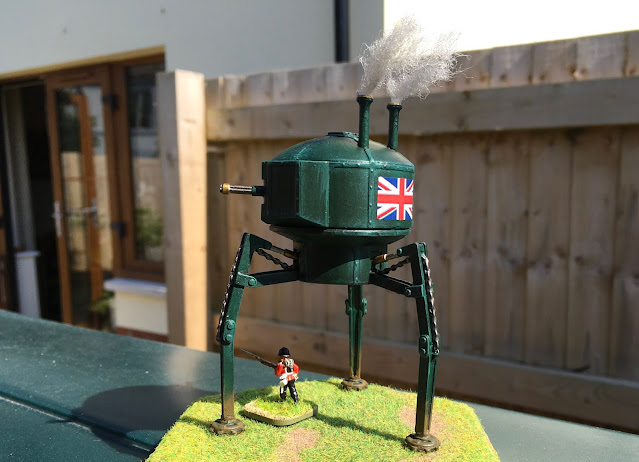The Martian invasion of 1880 caused the temporary abandonment of work on the London sewerage system as labour and capital were diverted to repair the extensive damage above ground. At the Queen’s request the sewerage systems designer and motivating force Joseph Bazalgette* was seconded instead to oversight of the enormous Vengeance Cannon project on Dartmoor.
The shaft of the cannon, angled to fire at Mars and bored nearly a mile deep into the Devon granite was an enormous undertaking funded by public subscription but Bazalgette, now in his early sixties, soon grew disinterested in it and devoted an increasing amount of his time to mechanical rather than civil engineering.
Granted access to the intact Dollis Hill tripod he was the first to identify an electrical gyro stabilisation system which the Martians were using to provide balance during locomotion. His experimental reproduction of this system with inferior earth technology produced similar results on a three legged vehicle he named the Bazalgette Rambler.
The properties of gyroscopes had of course been known and observed since ancient times, but their apparent gravity defying effect always wore off when the gyro wound down. By supplying their gyroscope with a constant source of electrical power the Martians maintained its effect for as long as was needed. Trialled in a closed off section of Hyde Park the Rambler greatly excited Queen Victoria who immediately decided she wanted tripods of her own. Of course what Vicki wanted Vicki got, and after three years of secret development the first Bazalgette Armoured Steam Walker clanked out of its shed.
Powered by 1 x twin stack Cockcroft / Serpollet flash boiler producing 350 horsepower the “wobblers” as they became derisively known could manage a healthy 4 mph over a 5 mile radius but couldn’t really turn for toffee. High ground pressure on modestly sized feet meant operation on anything other than concrete was problematic and climbing even gentle slopes was always approached with enormous trepidation. On the plus side its high ground clearance meant most regular obstacles could be stepped over and its towering 40ft height gave a commanding view of the battlefield.
The crew of three included a stoker / engineer, a gunner / loader and a vehicle commander / driver - who due to the very restrictive interior of the hull was forced to permanently sit half in and half out of the top hatch.
Armament consisted of 1 x 2.5 inch BL 7 pounder screw gun plus 1 x Gatling firing from a left and right sided sponson. Since only one of these weapons could be fired at any one time and ammunition storage was very limited, field conversions often deleted either the Gatlings or the screw gun.
Considering the Bazalgette to be a “dud” the Navy did not lobby hard for control of these Pocket Land Battleships and the Army, finding themselves a bit unsure about what to do with them as well, eventually created 2 new battery’s within a freshly raised brigade of the Royal Horse Artillery.
TTFN
*Special thanks are due to Colonel O’ Truth for highlighting Mr Bazalgette’s historic potential. His marvellous VSF blog is somewhere or other on the list to the right.


























